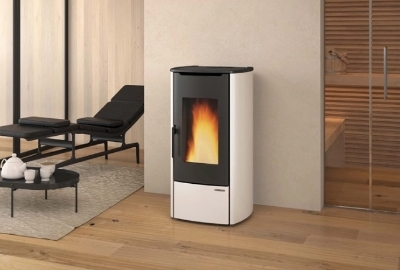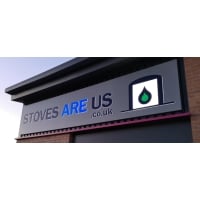An Introduction to Pellet Stoves
A wood pellet stove is a great alternative to traditional wood-burning stoves. The pleasure and warmth of burning wood with a real flame but none of the work needed to light it or keep it loaded.
A pellet stove can be set to fire up when you want the warmth and will automatically ramp down as the room comes to temperature. Picture a stove that lights itself before you wake up so that you come down to a warm kitchen. Set it to come on before you come home from work so that you’re greeted by a real fire and a cosy home. No storing logs or waiting for them to season, instead a clean, easily stored fuel there at your fingertips.
The ideal solution for whole-house heating might be a wood pellet boiler stove but that is a whole different ball game requiring hearing engineers and a more complicated installation. A dry pellet stove goes in as easily as a wood burner, either into an existing chimney or onto a twin wall flue. Site it well and it’ll spread its warmth around the whole house and the oil and gas boiler will barely get a look in. With the backlash growing against particulate pollution from wood burning, offering a range of pellet stoves can be good future-proofing for a stove business as they burn with no visible smoke, have very low emissions and at efficiencies well over 90%.
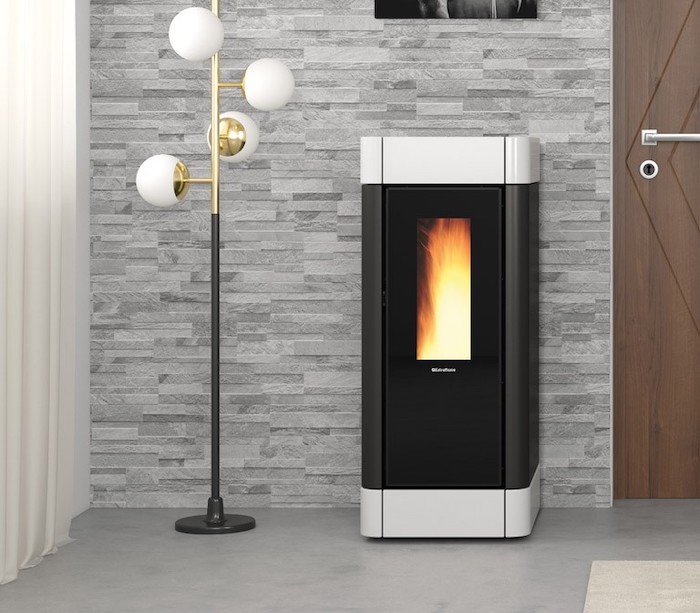
What is a Pellet Stove?
A wood pellet stove burns biomass pellets to create a source of consistent, controllable heat for the home. Wood pellet stoves operate in a very different way to traditional wood burning stoves, they steadily ‘feed’ pellets from a storage container into a burn pot area. This enables pellet stoves to precisely control the heat output and also be highly efficient. Some models can reach an efficiency factor of more than 90%.
Are Pellets a Good Source of Fuel?
Pellets are renewable fuels made from wood chips or saw shavings. They are available in 10, 15 or 25 kg bags
When burned in a wood pellet stove, one bag of pellets can provide up to a full day of steady heat. On average, a winter’s supply of pellets is 100 to 150 bags (2-3 tons).
A pellet stove can have efficiencies of over 95%, which is a great deal more efficient than a wood-burning or multi-fuel stove which sits around 80%, you will use less Kg of fuel per kW of heat produced.
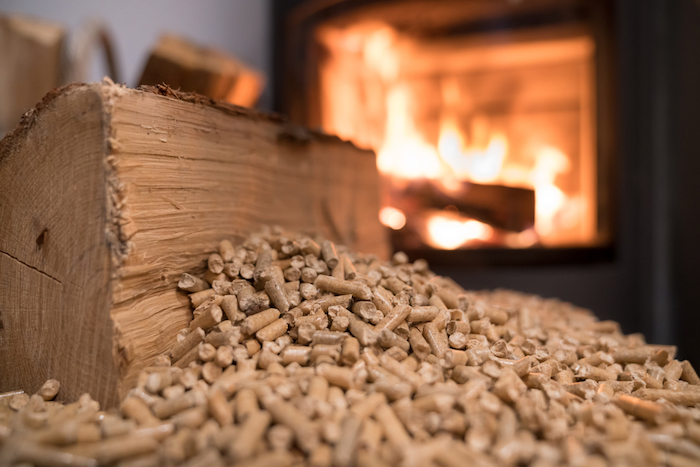
Can a Pellet Stove Heat all of my Home?
Depending on the size of your home and the location of the appliance a biomass stove could heat your entire house. We recommend talking with a qualified installer to provide expertise on how you can zone heat certain areas with a pellet boiler stove. Pellet boiler stoves are becoming more popular with the rising costs of gas and electric forms of central heating, pellet boiler stoves can heat your hot water and central heating at the same time as supplying heat to the room where the stove is installed in.
If you’re considering buying a pellet boiler stove you’ll be delighted to hear that they are highly controllable and very easy to light, unlike wood-burning and multi-fuel stoves you do not require firelighters and kindling. Pellet stoves can ignite the flame automatically and can be turned up and down by remote and even app based controls. Another advantage to a pellet boiler is that re-fuelling only needs to take place once a day or less depending on the hopper capacity and how heavily the pellet stove is running. Pellet boiler stoves can be installed in a new heating system or can replace or run alongside an existing heating system such as an air source, ground source, solar and traditional gas and electric by means of a thermal store or water storage cylinder. The thermal stores have numerous inlets and outlets which can be connected to all the other forms of water heating alongside the pellet boiler stove.
How do Pellet Stoves Work?
Pellet stoves make use of modern mechanical and electronic components to create a highly-efficient and controllable form of heating. As mentioned above, pellet stoves operate differently from traditional wood-burning stoves.
- The standard wood pellet stove will operate by being plugged into an electricity socket the pellet stove can be turned on.
- The operation will begin when the ignition has been hit. The wood pellets which are stored in the storage container (also known as the hopper) are moved from the stove to the combustion chamber.
- The pellets are moved using a device called a mechanised screw auger. As the pellets burn in the combustion chamber, like a traditional fire, the smoke and combustibles will be removed using an extractor. This waste air is moved, through the extractor and flue directly out into the air outside your home. This movement of smoke creates negative pressure, which pulls fresh air into the combustion chamber, thus feeding the fire.
- Fresh air is either pulled into the stove from your living room, or from outside via a duct (depending on the model of the stove).
- Warm air from the fire in the combustion chamber travels out into the room via convection.
Wood pellet stoves are beneficial as all of the above processes are monitored and carried out via a series of temperature and pressure sensors. For example, the mechanised screw auger won’t just continually deliver wood pellets into the combustion chamber. It’ll only do so when sensors tell it that more fuel is required in the chamber. This means that pellet stoves can operate autonomously (sometimes for as much as 12 hours under full load) and don’t have to be continually tended like a traditional wood-burning stove.
Do Wood Pellet Stoves Require a Lot of Maintenance?
Wood pellet stoves require simple maintenance to keep them running in tip-top condition. This includes periodically cleaning ash out of the burn chamber and the ash pan, scraping the burn pot, and keeping vital components free of ash. Once a year (or each time a ton of pellets has burned through it), your stove should be inspected and the chimney swept just like a standard wood-burning stove.
Pellets are a low-carbon fuel, so by heating with them, you are contributing to reducing greenhouse gas emissions. Pellet stoves also emit extremely low outside air particulates and are a fraction of the cost of other renewable energy systems like solar panels, geothermal heat pumps and wind turbines.
The Benefits of Pellet Stoves
- Cost-effective - The wood pellets can provide several days’ worth of heating depending on how long you run your pellet stove each day. When compared to the cost of electricity or gas, it quickly becomes apparent that pellet stoves offer a very cost-effective way of heating your home.
- Easy & clean operation - Once you’ve turned on the pellet stove, filled the fuel hopper and hit the ignition button, it’ll be able to run itself all day. On average, you’ll only need to fill the fuel hopper once a day (if you’re running the stove continuously). wood pellets generate barely any ash, pellet stoves don’t generate the sort of burnt materials of traditional stoves that have to be carefully emptied lest you get mess everywhere. Some models of pellet stoves feature self-cleaning combustion chambers, whereby any ash or combustibles that are left after a fire are ‘burnt off’. This means there’s practically no cleaning or maintenance for you to do.
- Eco-friendly - The wood pellet stoves are very environmentally friendly. Not only do they create almost no ash when burnt, but they are also generally sourced from sustainably-managed forests. They are also considered to be carbon neutral, as the amount of CO2 they give off when burnt is equal to the amount of CO2 the tree absorbed when it was growing.
- Energy efficient - Pellet stoves are an energy-efficient way of keeping your home heated. They have a very low moisture content, meaning they give off a large amount of heat. Not only is the fuel source highly efficient, but the pellet stoves are too. The very best pellet stove models can achieve an efficiency factor of over 90%.
The Drawbacks of Pellet Stoves
- Pellet stoves generate noise - Pellet stoves make a small amount of noise when in operation. We recommend visiting a showroom before purchasing so you can hear the noise levels yourself (albeit very low noise levels).
- Electricity is required - Due to the automatic ignition and fan within a pellet stove they’ll need to be connected to your mains electrics.
- Is the flame aesthetically pleasing - Unlike a wood burner, pellet stoves produce a flame that is vibrant and lively. With a pellet stove, you will experience some ambience but not the dynamic flames, embers and crackle of a log burner.
- Complex system - As mentioned above pellet stoves require an electrical connection for their moving components, these parts need to be maintained annually and if something goes wrong they can require a bit of troubleshooting to fix.
What to Consider When Buying a Pellet Stove?
Positioning of the pellet stove
Where you decide to place the pellet stove in your home will influence what size and heat output of the pellet stove you will need to buy. Pellet stoves are available with a wide range of heat outputs, from under 5kW for very small living rooms, all the way up to 12kW or higher for the largest open plan spaces.
Pellet stove ventilation
Pellet stoves also require a source of fresh air to feed the fire in the combustion chamber. Some stoves will be able to draw fresh air directly from your living room. Others will need to draw air from outside of your home. In the case of the latter, the stove will need to be placed against an external wall of your home to accommodate an external air duct.
Powering your pellet stove
Whilst pellet stoves don’t use much electricity to operate, they do still need to be plugged into your mains electricity.
Maintenance of your pellet stove
Pellet stoves don’t require the same level of maintenance as traditional wood burning, however, they do still require some maintenance. Highly-efficient combustion chambers will reduce the amount of ash, thus reducing required maintenance and cleaning even further.
Noise & Controls
Premium pellet stoves such as La Nordica mean they are designed to operate quietly. Whilst pellet stoves can operate autonomously once they’re up and running, you need to make sure you’ll be able to get them up and running in the first place.
Selecting a trusted pellet stove brand
La Nordica has decades of experience building sought-after pellet stoves. Hailing from the North East of Italy, La Nordica has been manufacturing stoves and related heating appliances for over half a century. La Nordica offer two-year guarantees on their stoves, so should anything go wrong, you’ll have the backup to make things right again.
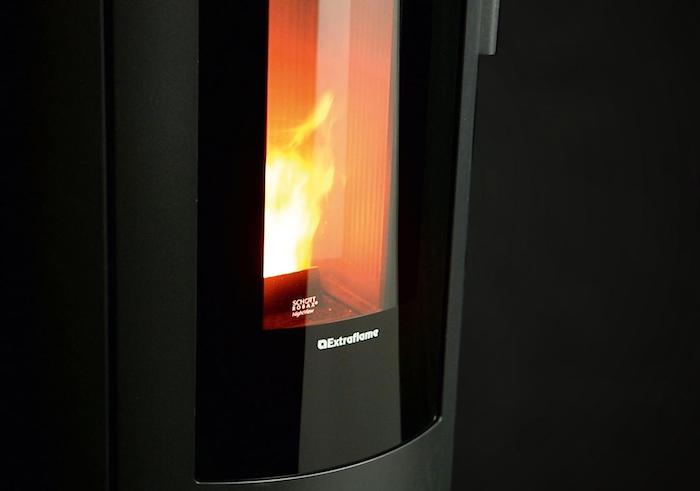
Pellet Stove Conclusion
A pellet stove can be a fantastic addition to your home, a good quality stove can typically last over 10 years if it has been well-maintained.
They are easy to start up, efficient and highly controllable. If you’re wanting a heating product from the ‘stove family’ that you can control far more easily than a log burner then a pellet stove could be perfect for you.

